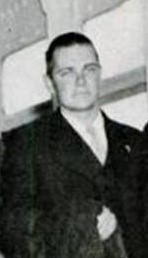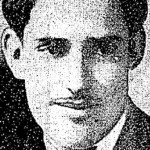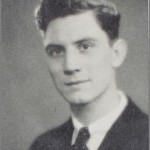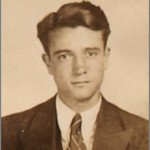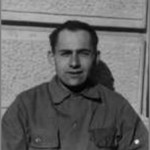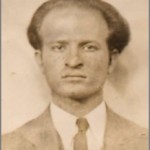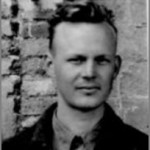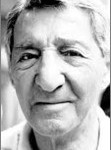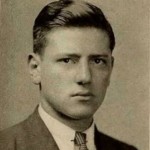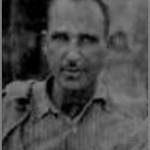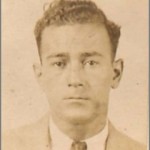Commoners in Spain: Students, Faculty, and Alumni of Commonwealth College in the Spanish Civil War
k-Indicates killed or missing in action
k –(Canadian) Arvid Carlson (also known as Arthur) was born in Pittsburg, Pennsylvania around 1909. His family was of either Finnish or Swedish background. Carlson likely attended Commonwealth College at some point in the 1930s. He joined the Canadian Communist Party in 1932. Carlson was single and living in Port Arthur, Ontario when he volunteered to serve in Spain. He arrived in Spain on March 14, 1937 and served with the XVth International Brigade. He was one of forty Canadians who transferred into the Lincoln Battalion in June 1937. Later he served in the medical services (Sanidad) and was wounded in action in at Teruel. He died of his wounds in Murcia hospital in January 1938. Carlson appears on both the American and Canadian lists of volunteers.
Van Rensalaer Chase, Jr. was born on January 6, 1914 in Calgary, Canada to Van Rensalaer Chase, Sr (1885-1931) and Hallie Inez Sullivan Chase (1880-?).[i]
He attended the University of Wisconsin for one semester and later enrolled in Commonwealth College. He joined the U. S. Communist Party in 1934. He was single and had worked a wide range of jobs including as a seaman, currier, janitor, Communist Party functionary before volunteering to serve in Spain. His passport application indicated that he lived in New York City and he sailed for Europe four days after receiving his passport, on May 25, 1937 aboard the Brittannic. Chase arrived in Spain on June 18, 1937 and trained with the XVth International Brigades, Mackenzie-Papineau Battalion. Later he served in the Spanish 24th/59th Battalion in the Battalion Headquarter (Estado Mayor) as a Telephonist. He was captured by Nationalist forces on April 1, 1938 near Gandesa during the Retreats. He was imprisoned in San Pedro de Cardeñas for six months before being exchanged on October 8, 1938. He returned to the U. S. on October 18, 1938 aboard the Queen Mary. During the Second World War Chase attempted to enlist in the U. S. Army but was turned down due to health complications from his service in Spin. Determined to serve he joined the Merchant Marine. Chase died on October 24, 1985 in Los Angeles, California. Chase appears on both the US and Canadian lists of volunteers.
k-Henry Griffin Eaton was born on December 22, 1909 in Santa Monica, California to Frederick Eaton (1855-1934) and his second wife, Alice Viets Slosson Eaton (1876-1964).[ii] Eaton’s father was a former Mayor of Los Angeles. Eaton attended Commonwealth College in 1935 and was elected student body President. Eaton was a member of the US Communist Party. He was living in San Francisco and working as an organizer for the International Labor Defense when he volunteered for Spain. He sailed for Europe on March 5, 1937 aboard the Britannic. In Spain he served with the XVth International Brigade in the Washington Battalion and served as a section leader in Company 3 during the Brunete Campaign. He remained with Company 3 when the Washington and Lincoln Battalions merged. During the Aragon campaign Eaton was promoted to Commissar in the company and held the post when he was killed in action on September 3, 1937 at Belchite. The Los Angeles Chapter of the Veterans of the Abraham Lincoln Brigade (VALB) was named the Henry Eaton Chapter in his honor.
k-John Field was born on March 3, 1913 in Villerica, Paraguay to Ralph H. Field (1879-1960) and Alice Field (b. August 26, 1879, Edinburgh, Scotland).[iii] His brother William was born on February 12,1919 in Sao Paulo, Brazil and shortly afterward the family returned to the United States. His father established the family in Rochester, New York and his first marriage ended. The family broke up after Ralph’s second marriage and business failed. John and his brother were placed in the care of the Barnes family who fostered them through high school. John Fields graduated from West High School and entered the University of Rochester where he was a popular student and a stand out runner captaining the cross country team. John was elected Vice-President of the class of 1935. He was also active in the Y.M.C.A. Council and served as the yearbook circulation manager.[iv] After graduating from college worked as a salesman and in 1936 joined the US Communist Party. In the spring of 1937 Field joined his father and enrolled in Commonwealth College. Together they left fight in Spain sailing for Europe in June 1937. In Spain Field served with the Mackenzie-Papineau Battalion. He quickly rose to leadership as an assistant section leader in Company 1. Field served at Fuentes de Ebro and in December was transferred to Tarazona as an instructor. He rejoined the Mackenzie-Papineau Battalion just before it deployed to Teruel. John was killed in action on January 19, 1938 outside Teruel while serving as a section leader in Company 3. During the battle he led two sections to reinforce a critical hill top position of the line. Arthur Landis noted that “of the fifty men who occupied the hill 45 were casualties” this number included John Field.[v]
Ralph Higbee Field b. July 16, 1879 (1877), Leon, Iowa to John Field (1853-?) and Martha “Mattie” Sophronia Higbee Field (1854-?).[vi] He trained as a civil engineer but practiced a wide range of vocations. Field worked as an International Labor Defense organizer, cowboy, forest ranger, landscaper, and college instructor. He lived for several years at the Liano Cooperative Colony before moving to South America. In 1904 in South America he met and married Alice, a Scottish immigrant.[vii] Their son John (1913-1938) was born in Villerica, Paraguay and William (1919-?) was born in Sao Paulo, Brazil. Shortly after Will’s birth, the family moved to the United States and settled in Rochester, New York. Ralph established a landscaping business. He divorced Alice in 1923, and married Olive Mabel Bridge in 1926. Shortly thereafter the business failed and his second marriage ended. John and Will moved in with Mr. and Mrs. William Barnes of Rochester who served as their foster family. John found work on the full-time staff of Commonwealth College. He served as the maintenance and groundskeeper as well as teaching several classes. Fields maintained a close relationship with his sons. In the spring of 1937 his son John enrolled in Commonwealth College after graduating from the University of Rochester. In May 1937 Ralph and his son John left for Spain. They arrived in Spain on June 15, 1937 and Ralph attempted to pass himself off as the older brother of John so they could serve together in the XVth Brigade’s newly formed Mackenzie-Papineau Battalion. The ruse was unsuccessful and Ralph Field was assigned to the Battalion Headquarters (Estado Mayor) where he worked as a quartermaster and later in the medical section (Sanidad). John Field was killed in action on January 19, 1938 during the battle of Teruel. Ralph Field was devastated and, in the summer of 1938, he was repatriated. Field returned to Commonwealth College and resumed his duties as maintenance man and instructor.
The Commoner carried a short article about Ralph Field in its June 1939 issue:
To incoming students eagerly studying a Commonwealth catalog, the phrase “Effective Speaking” and the name “Ralph Field” mean very little. But they are not long on campus before they realize that behind these names is an unusual personality and an unusual philosophy, The personality of Ralph’s own. The philosophy is of a long and colorful life. A life that has included all sorts of adventures generally left to the imaginations of fiction writers.
A year ago, Ralph returned from the bloodiest-battle of our time— Spain. No longer young, he had left Commonwealth with his son John and joined the thousands of internationalists who went to fight Fascism in Spain. Over the Pyrenees he hiked, keeping up with his young son, seeing some fall in exhaustion by this initial test of endurance, seeing some lost by the way. In Spain he did a man-sized job. He was saddened by the death of his son. When he returned he was unnerved by the mass suffering of the Spanish people.
Today Spain is not for Ralph a tragedy over which to brood. He is more interested in the immediate task of worker’s education. To him, Spain is a poignant lesson for history; and a challenge to educate workers for Democratic action, before it is too late.
His class in effective speaking is a small part of his work at Commonwealth. Through the day he is hard at work at other tasks— helping a student prepare a talk, discussing the work of the College with other Commoners, trying to correct the appalling mistakes of amateur carpenters in a cottage he is rebuilding. He has put new roofs on [the buildings] Library and Commons, and with little help. Every task receives the same fierce attention.
“He is a rich old man,” someone said. At Commonwealth, where old and young live in the familiarity of first names and easy fellowship, it is hard to think of Ralph as “old.” But he is rich in the history of our struggle, for he is part of it. Rich in life, for he has lived it fully. And rich in the desire to teach others— for his work is not done.[viii]
Ralph Field died on March 29, 1960 in lower Milford, Lehigh, Pennsylvania.
For More on John and Ralph Field see “Family Bonds,” The Volunteer Blog.
Harry Fisher was born on March 12, 1911 in Brooklyn, New York. He was placed with the Brooklyn Hebrew Orphan Asylum on May 18, 1913 where he lived until he was sixteen.[ix] Fisher graduated from the Brooklyn High School of Commerce and attended Commonwealth College in fall of 1932. He joined the Young Communist League in 1932. Fisher was one of twenty-eight students who left Commonwealth after the administration expelled the six ring-leaders of a strike to integrate the college.[x] After leaving Commonwealth Fisher worked a wide variety of jobs including as a bus boy, farm worker and seaman before he found a stable job working in a department store where he became a member of the Department Store Employee’s Union.
Fisher was single and living in Brooklyn when he volunteered to serve in Spain in the winter of 1936. After receiving his passport on February 11, 1937, he sailed for Europe aboard the Ile de France on February 20, 1937. He crossed from France into Spain arriving on March 7, 1937 and after receiving training was posted to the XVth Brigade, Lincoln Battalion, Company 1, as a runner. Fisher later transferred to the Brigade Transmissiones. He served at Brunete, Quinto and Belchite, after which he was offered repatriation. Fisher ended up working in Albacete instead of going home and later rejoined the Lincoln-Washington Battalion, serving in the Plaza Mayor (Headquarters). He was repatriated in the late summer of 1938 and returned to the US on September 21, 1938. Fisher’s Mother and sister were at the dock to meet him along with Ruth Goldstein a representative from his union. Fisher married Ruth in 1939. During World War II he served in the US Army Air Force as a bomber turret gunner in France, Belgium and Germany. Fisher later joined the staff of the New York office of the Russian paper Tass. Fisher was active in VALB and wrote his memoir Comrades, Tales of a Brigadista in the Spanish Civil War. Fisher died on March 22, 2003 after collapsing at an anti-war rally.
For additional information on Harry Fisher see his book Comrades, Tales of a Brigadista in the Spanish Civil War, Lincoln: University of Nebraska Press, 1997.

John Londragon from Scotland and Peter Frye. Photograph courtesy Thelma Ruby, Drawing by Virginia Donaldson from the Commonwealth College Fortnightly.
(Canadian) Peter Frye, whose birth name was Peter Friedman, was born on May 8, 1914 in Montreal, Canada to Jack Friedman and Celia Friedman Russian immigrants.[xi] Fry’s father was a Socialist organizer and a founding member of the Canadian Labor Party. In the 1920s his father was barred from work due to his political activities and forced to leave Canada to make a living for several years. Frye became politically active joining first the Poale Zion, and later the Young People’s Socialist League, before joining the Young Communist League (YCL) in 1929. Fry attended Baron Byng High School and later entered the Ecole des Beaux Arts for architecture. Frye left before completing his coursework. As a member of the YCL he became active in agitation-propaganda work and developed the desire to become an actor. In 1932, when he was 18 years old, he crossed into the United States. He worked with various left wing acting troops before being offered a position as an instructor in Theater Arts at Commonwealth in 1935. Fry joined the Communist Party the same year.
Frye recalled “I didn’t get much pay—I got some pocket money—but I got my food and my housing, and what did I have to give in return? First of all, my labor – teachers, students, all belonged to various work teams.” He was on the wood cutting team and despite the back-breaking work recalled that “It was a quite marvelous place.”[xii]
After a single quarter Frye moved on and found work with various theaters and the Works Project Progress Administration Federal Theater Project. Frye volunteered for Spain in the spring of 1937. He arrived in Spain on June 18, 1937 and after a brief training period he joined Company 1 of the Lincoln-Washington Battalion in the XVth International Brigade. Frye fought at Quinto and Belchite. While in action at Belchite he was shot in the arm resulting in the permanent loss of use of three fingers on his right hand. Frye returned to the United States on March 12, 1938 aboard the Queen Mary. Post war he went on to a distinguished career in theater as both an actor and director. Frye was married three times the first to May Garelik (1903-1990) on March 22, 1938. His first marriage ended in divorce in 1948. A second marriage to Batia, an Israeli citizen in 1952 also ended in divorce in 1970. In 1970 Frye married Thelma Ruby a union that lasted through the end of his life. Fry died in June 1991 in Sutton, Surrey, England. Frye’s account of his service in Spain, in the joint autobiography with Ruby is one most candid accounts of the conflict. Fry appears on both the American and Canadian lists.
For additional information on Peter Frye see Thelma Ruby and Peter Frye, Double or Nothing: Two Live in the Theater (London: Janus Publishing ), 1997.
Benjamin Goldring was born on May 13, 1912 in New York City to Albert Goldring (1885-1971) and Minnie Reiss Goldring (188s7-1971).[xiii] A stand out student, Goldring graduated from law school. In the summer of 1936 he attended Commonwealth College and was elected to the school’s Disciplinary Committee.[xiv] Goldring joined the US Communist Party in October 1936. From December 1936 to May 1937 he served in the New York National Guard’s Company L, 245th Coastal Artillery in preparation for service in Spain. Goldring was single and working as a lawyer in New York when he volunteered to serve in Spain. He sailed for Europe on May 8, 1937 the American Importer and after crossing the Pyrenees arrived in Figueres, Spain on May 27, 1937. Goldring joined the Washington Battalion on June 2, 1937 in Madrigueras where the unit was forming and undergoing training. He served as a runner for the Estado Mayor (headquarters). He fought at Brunete and remained with the unit when it merged with the Lincoln Battalion. Goldring was wounded by shrapnel at Quinto and recover in the hospital in Orihuela. He returned to the unit in time to participate in the battles of Teruel, Segura del los Baños and The Retreats. During the later action he was again wounded this time in the ankle in combat near Batea. After recovering from his second wound he was posted to a rear area to recover and did not serve in the Ebro Offensive. Goldring returned to the US on December 20, 1938 aboard the Ausonia. Goldring re-enlisted in the New York National Guard in 1940. After World War II Goldring led a long and successful legal career which included legal representation of the Veterans of the Abraham Lincoln Brigade. A debilitating stroke left him wheel chair bound for the last years of his life. Benjamin Goldring died on April 17, 2000 in New York City.
k-Norman Emmet Law was born September 17, 1910 in Hammond, Lake, Indiana to Robert Emmet Law (1881-1946) and Alvina W. Nack (1883-1962).[xv] Robert Law owned a welding plant in Hammond. Norman Law studied printing in high school but after graduation was unable to find steady work. In the fall of 1936 he entered Commonwealth College and helped put out the school’s paper the Fortnightly.[xvi] He returned home in September of 1937 and left for Spain in December 1937. In Spain he enrolled in the International Brigade and served with the XVth Brigade. Law was serving as a private (Soldado) with the Lincoln-Washington Battalion when he was reported missing in action on March 10, 1938 in the Caspe-Belchite sector during the Retreats. His younger sister Alegra recorded a brief memory of her brother:
Norman was my worst and my best friend, but always my friend. He teased and taught me, corrected me and backed me up. He had only to lift his eyebrows at me from across the table to send me into the giggles, and my mother would say “Now what did he do?”
He didn’t want to be a welder, so he studied printing in high school. When he graduated in 1929, the depression started and he couldn’t find work. He got jobs away from home, Eureka, Iowa, Erie, Penn, and Commonwealth College, Ark.
Commonwealth taught Politics, ways of sabotage, under ground work, and Socialism. He came home September 1937 and said he had to leave before Christmas for a job. I had no idea he was going to Spain to fight in the revolution against Franco.
He saw a lot of Elizabeth and Dona while he was here. After he left, the first letters came from England, then Spain. He wrote about the country, and planes, and was sure our country would be involved soon to stop Hitler.
In March there was a battle that sent the Lincoln Brigade into retreat. Norman was reported missing. We read in the paper Law, Norman was found dead by the Franco troops, he was 28. I held on to the idea that Norman could have slipped into the underground, he spoke some German.
Abraham Joseph Levine was born on October 26, 1914 in Boston, Massachusetts to Isaac William Levine (1890-1964) a Russian immigrant and Sybil Mannis Levine (1893-1954) an English immigrant.[xvii] He graduated from Boston University with a BS in Journalism. Levine was working as a clerk in the shoe trade and a member of the Young Communist League when he volunteered to serve in Spain. He arrived in Spain on August 15, 1938 and after a brief training period joined the XVth International Brigade on the Ebro Front. He served with the Lincoln-Washington Battalion, in the 1st, 3rd and Machinegun Companies and was wounded by shrapnel. Levine returned to the US on December 15, 1938 aboard the Paris. After his return he entered Commonwealth College for the spring 1939 quarter and studied labor journalism. During World War II he served in the US Army.
Harold David London was born on September 29, 1915 in Philadelphia, Pennsylvania. He was the youngest child of Isaac London (1864-1952), a manufacturer of hats, and Anna Glass London (1872-1967?), a housewife. Both of his parents were Lithuanian immigrants who became naturalized citizens in 1886.[xviii] London attended Commonwealth College and was a member of the US Communist Party. He was single and a student when he volunteered to serve in Spain. London sailed for Europe on April 21, 1937 aboard the Manhattan. After crossing into Spain he joined the International Brigades and trained with the newly formed George Washington Battalion. He fought at Brunete and was wounded in action. After recovering he rejoined the XVth Brigade in the merged Lincoln-Washington Battalion and fought at Belchite. London returned to the US on November 15, 1937 aboard the Queen Mary. He later married Gertrude Finkel London (1911-2007) and together they had one child. London died on October 14, 1989, and was buried in Montifiore Cemetery, Workman’s Circle Section, Elkins Park, Pennsylvania.
k-Morris Matz (Morris Katz, Motz, Metz), was born on December 4, 1909 in Susquehanna, Pennsylvania to Abraham Matz (1885-?) a laborer and Anna Hyat Matz (1892-?) a housewife. Abraham Matz and his wife were both Russian immigrants. Morris Matz joined the US Communist Party in May 1935 and attended Commonwealth College in 1936.[xix] He was living in Binghampton, New York and listed his vocation as clerk when he volunteered for Spain. In Spain Matz served with the XVth International Brigade in the Lincoln-Washington Battalion. Matz was a private (Soldado) when he was killed in action in April 1938 near Gandesa, during the Retreats.
Harry Mensh was born on January 23, 1908, in Sutton, West Virginia to Marcus Mensh (1867-1954) and Rebecca “Sarah” Volk (1872-1919). He had seven siblings: four sister and three brothers.[xx] Mensh graduated from the University of Florida in Gainesville and did graduate work at John Hopkins University. He worked as a seaman in the early 1930s and joined the US Communist Party in 1933. Mensh married Mariam Darack (1911-?) in 1932 in Duval, Florida. He later worked as a party functionary. After Mensh’s returned from service in the Spanish Civil War he took a position as an instructor in economics at Commonwealth College for the Fall Quarter of 1938. On July 7, 1942 Mensh enlisted in the US Army. He married Elaine H. Rosenblatt (1924-2001). Together with his wife they wrote The I. Q. Mythology: Class, Race and Inequality & Black, White and Huckleberry Finn: Re-Imagining the American Dream. Mensh died on January 22, 2002 in New York City.
Marion Noble was born on May 4, 1911 in Garner, Arkansas to Isom Jerry Noble Sr. (1882-1958) and Cora Abigail Scruggs Noble (1886-1961).[xxi] Noble attended several colleges and universities including the University of Arkansas for two years, Illinois State Normal University for a half-year, and in the spring of 1933 he enrolled in Commonwealth College and served as the Industrial Manager.[xxii] Noble’s roommate at Commonwealth was Bob Reed. He joined the US Communist Party in 1931 and was living and working in Detroit, Michigan when he volunteered to serve in Spain. Noble sailed for Europe on July 21, 1937 aboard the Berengaria and crossed into Spain on August 1, 1937. Based on his vocation as a mechanic Noble was assigned to the Albacete Auto Park, Ursine no. 1. After the Retreats in the spring of 1938 he was sent to the XVth Brigade as a rifleman. When the chain of command recognized his skill as a mechanic he was quickly pulled out of the ranks to establish an auto shop for the brigade. Noble served with the brigade through the Ebro Offensive. He returned to the US on December 15, 1938 aboard the Paris. Noble married Ruth Friedman (1916-2004) on March 23, 1943 in Detroit, Michigan and they raised their daughter Rebecca Noble (1953-1987). Noble worked as a mechanic until retiring at which point he opened a successful carpentry business. He wrote a memoir remains unpublished. He died on October 5, 2002, in Huntington Woods, Oakland, Michigan.
For more information on Marion Noble see his article “Keeping the Vehicles Rolling,” The Volunteer, Volume XI, No. 2, December 1989 reprinted on The Volunteer Blog.
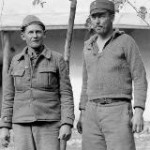
Eugene Poling and James “Doc” Hill, both from Oklahoma and received citations, November 1937. The 15th International Brigade Photographic Unit Photograph Collection; ALBA Photo 11; ALBA Photo number 11-0984. Tamiment Library/Robert F. Wagner Labor Archives. Elmer Holmes Bobst Library, 70 Washington Square South, New York, NY 10012, New York University Libraries.
Eugene Victor Poling, better known as Eugene “Debs” Poling, was born on August 26, 1908 in Lone Wolf, Oklahoma to Alonzo B. Poling (1854-1948) and Hattie Viola Deweese Polin (1876-1957).[xxiii] Poling attended school through the 11th grade and worked as an Agronomist and driver. He married Mayona Miller and together they had two daughters Sussana (1933-2016) and Wanda Jean (1935-?). Poling took on the middle name “Debs” as he became active in progressive politics. He attended Commonwealth College and in 1935 joined the US Communist Party. Poling volunteered for Spain in the Spring of 1937 and sailed for Europe on June 16, 1937 and crossed into Spain on July 3, 1937. He served with the XVth International Brigade’s Mackenzie-Papineau Battalion. During the unit’s first action at Fuentes de Ebro Poling was wounded in the thigh by a piece of shrapnel. After recovering he rejoined the battalion and during the Retreats he was captured. After a year in San Pedro de Cardenas Poling was released on April 22, 1938. He returned to the United States on May 6, 1938 aboard the President Harding. Poling divorced his wife in 1942 and in 1944 he joined the US Army. He served with the 4th Army as an information and education officer Fort Hood, Texas before being released from service in December 1945. Poling later married Juanita Louise Folson (1922-1980). He worked as a farmer and agronomist in and around Dougherty, Oklahoma and remained active in politics. Poling ran numerous unsuccessfully campaigns for Congress as a Democrat. Eugene Debs Poling died on February 29, 2000 in Clinton, Custer, Oklahoma. He is buried in Lawnview Cemetery, Cordell, Oklahoma.
For More on Eugene Debs Poling see Andrew Griffin’s, “From Oklahoma to Spain: Fighter for Justice,” The Volunteer blog.

Mary Rader from a group photograph of the 3rd American Medical Bureau group aboard the Aquitania; FM Collection.
Mary Jane Rader was born on September 25, 1897, in Welchburg, Kentucky to Elisha Smith Rader (1868-1949) and Ollie Frances Ponder (1877-1915).[xxiv] She trained as a nurse at Lakeside Hospital in Chicago, Illinois. Rader married William B. Ochs (1884-1964) on December 18, 1934 in Indiana. When she volunteered for the American Medical Bureau she was separated and living in Chicago, Illinois. Rader sailed for Europe on June 30, 1937 aboard the Aquitania and arrived in Spain on July 19, 1937. She served as a nurse with the medical services. After leaving Spain in 1938 she accompanied Ralph Field to Commonwealth College. She accepted a position as a nurse and community worker. While she was living at Commonwealth Rader lost all of her physical belongings when the Monastery building on campus burned down in April 1939. She had moved all of her belongings to her new room but “had not yet occupied the room.” She estimated her losses at more than $300.”[xxv] Rader died on April 9, 1968.

Bob Reed, International Brigade Archive, Moscow: Select Images, Folder 188: 15th International Brigade Volunteers, Portraits, 1937-38, Box 2, Folder 14; ALBA Photo 177; ALBA Photo number 177-188031. Tamiment Library/Robert F. Wagner Labor Archives. Elmer Holmes Bobst Library, 70 Washington Square South, New York, NY 10012, New York University Libraries Photo.
Robert Lee Reed was born on July 6, 1914 in Coolidge, Texas. Reed was one six children in a family of cotton farmers. The Reed family worked as tenant farmers across Texas through some of the worst days of the depression. Falling cotton prices caused the Reed family to live on the verge of poverty. Bob’s parents made significant sacrifices to get him through high school. Reed attended Commonwealth College beginning in 1932 and studied labor history.[xxvi] He served as student farm manager and volunteered as an organizer for the Southern Tenant Farmer’s Union (STFU). Reed’s roommate Marion Noble would also fight in Spain. In 1933, Reed joined both the Communist Party (CP) and the Young Communist League (YCL) and served as the Arkansas state organizer. During the winter quarter of 1934-35 Reed taught courses as part of “specialized farm course.”[xxvii] Reed later moved to Detroit to continue his party work. In the spring of 1937 he volunteered for Spain, sailing April 24, 1937 aboard the Vollendam. Reed was among the volunteers being transported to Spain by the coastal freighter Ciudad de Barcelona when it was torpedoed. After survived the sinking, he trained in Tarazona with the XVth International Brigade’s Mackenzie-Papineau Battalion. Reed fought at Fuentes de Ebro, Teruel, Seguro de los Baños, the Retreats and Ebro Offensive. He was wounded in action three times during the war. Reed returned to the US on December 15, 1938 aboard the Paris and resumed his party work. During WWII he joined the US Army and served in the Quartermaster Corps assigned to the 8th Air Force Service Command. He later transferred to the 9th Air Force’s Service and Engineer Command with the rank of Master Sergeant. Post war he married Mildred Aslin and continued his party work, serving as the circulation manager of a new Detroit workers’ paper, The Herald. In 1961 Reed left the party. Reed, his wife and two children Bill and Janet moved to Seattle, Washington. He returned to school and earned a Master’s degree in Social Work from the University of Washington and after graduation worked as the director of a service center for the residents of a low-income housing community. After retiring, Reed split his time between volunteer activities with various progressive causes and his weekend home in Snohomish. From the 1970s to the mid-1990s, Reed and fellow veteran Oiva Halonen completed a project collecting history of the Spanish Civil War volunteers from the Pacific Northwest. Bob Reed died on January 29, 2005 in Seattle, Washington.
The Reed Collection is part of the Special Collections Archives in the University of Washington. These files are also part of the Abraham Lincoln Brigade Archive in NYU, as ALBA 82 and Robert Reed Northwest Volunteers Research Project Records and ALBA.PHOTO.005, Robert Reed: Northwest Volunteers Research Project Photographs.
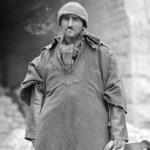
Samuel Romer, 24th Battalion, January 1938. The 15th International Brigade Photographic Unit Photograph Collection; ALBA Photo 11; ALBA Photo number 11-0946. Tamiment Library/Robert F. Wagner Labor Archives. Elmer Holmes Bobst Library, 70 Washington Square South, New York, NY 10012, New York University Libraries.
Samuel Romer was born on September 21, 1912 in Detroit, Michigan to Harry Romer (1885-1948) and Mila “Molly” Nechamen (1883-1946).[xxviii] He joined the Socialist Party in 1927. Romer graduated from the University of Michigan with a Bachelor of Arts in Journalism. Fellow veteran Harry Fisher recalled that Romer attended Commonwealth College in 1932. Romer married Edna Drabkin on April 12, 1937 in Manhattan and left for Spain the next month. Edna Romer also served in Spain, as a nurse with the American Medical Burea. Romer survived the sinking of the Ciudad de Barcelon on May 30, 1937 and joined the Mackenzie-Papineau Battalion at the training camp in Tarazonna. He later transferred into the XVth Brigade Estado Mayor (headquarters) as Staff Paymaster. He was serving with the 59th Battalion, a predominately Spanish unit in the XVth Brigade, when he was captured on March 12, 1938 near Hijar during the Retreats. He was imprisoned in San Pedro de Cardenas and exchanged on October 8, 1938 and arrived back in the US ten days later. Romer wrote about his time as a POW in an article entitled “I Was Franco’s Prisoner,” in the The Nation published on November 19, 1938. During World War II Romer served in the US Army as a Meteorologist. After the war he worked as a civilian consultant to General MacArthur in Japan. Samuel Romer died in 1965.
Max Shufer was born on September 7, 1914 in Manhattan, New York to Solomon Shufer (1891-1974) and Anna Katz Shufer (1891-1972).[xxix] Shufer graduated from Morris High school then attended the City College of New York (CCNY) spending a summer at Commonwealth College. He joined the US Communist Party in 1935. Shufer graduated from CCNY Phi Beta Kappa with a Bachelor of Science degree in 1936. He attended the Massachusetts Institute of Technology (MIT) the following year. In 1937 he applied for a passport under the name “Irving Rabinowitz,” which led to the nickname “Rabbit,” and arrived in Spain on July 15, 1937. He attended Officer Training School (OTS) and after graduation was assigned to the XVth International Brigade, Lincoln-Washington Battalion’s Machinegun Company as a Section Leader with the rank of Corporal (Cabo). During the Retreats he was captured and spent a year in San Pedro de Cardeñas. He was released on April 22, 1939 and returned to the US on June 23, 1939 aboard the Manhattan. He completed his graduate degree in physics at Columbia University. During WW II he served as a physicist at the National Bureau of Standards. Shufer married Shirley Aldor Shufer (1926-?) in 1961. Shufer later worked as a physicist and electronic engineer at Memorial Sloan-Kettering Institute in New York City retiring after 30 years. He was an avid cyclist and loved the opera. Shufer died on March 31, 2006 at his home in Pawling, New York.
For more information on Max Shufer see Jane Shufer’s “Engineering Career Derailed: Max Shufer and the FBI,” The Volunteer, V. 23, No. 5, Winter 2001, pp. 9-11.
k-Paul Sigel was born on August 29, 1915 in Pittsburg, Pennsylvania to David Sigel (1882-?) and Hannah Lipman Goldotsky Sigel (1887-? ) who immigrated from Belarus, Russia.[xxx] As a student at New York University in the 1930s he was active in progressive political activities. In 1932 he joined the Young Communist League and the US Communist Party. During the summer quarter of 1935 Sigel attended Commonwealth College. He graduated from New York University in 1937 and shortly afterwards departed for Spain. He sailed to Europe on June 5, 1937 aboard the Lancastria. After arriving in Spain he joined the Mackenzie-Papineau Battalion in Tarazona where it was forming. He served in the Communications (Transmissions) Section and was killed in action in April 1938 near Gandesa during the Retreats. His mother Hanna Sigel sent a letter to Commonwealth College about the death of her son that was printed in The Commoner.
The Commoner, V. 1, No. 11, April 1939, p. 2
Dear Comrades of Commonwealth College:
This is Paul Sigel’s mother writing to you after receiving the Campus Bluff with the “Notes about Commoners.” You probably often wondered why you haven’t heard from Paul for so long. You must know how intensely interested he was in the College since he attended in the summer of 1935.
You evidently have not been informed, but you should know that another Commoner went to Spain to fight Fascism, and never returned.
Paul went across in June 1937. He was assigned to the Communications Corps of the Lincoln Brigade—having been a graduate Electrical Engineer from New York University just before he sailed. For a while he was instructor of Communications; but, according to comrades who returned, he fretted that he wasn’t sent to the front until he was relieved of his duties as instructor and sent to the front. For a long time no news was received from him. Officially here his death has not been confirmed; but I have it on as good authority as I shall ever get that he was wounded in battle and died in a field hospital.
Needless to say I am intensely proud of my son. He consciously and joyously went to help Spain fight Fascism and gave his life willingly so that his ideals may survive. His letters from Spain were full of the joy of living. His enthusiasm for the struggle, his love of his fellow soldiers in the struggle, was the dominant note in all his letters. Comrades who returned from Spain speak of him in glowing terms.
I just wanted you to know—because he loved Commonwealth.
Hannah Sigel
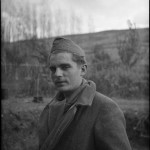
Clyde Taylor, Mackenzie-Papineau, November 1937. The 15th International Brigade Photographic Unit Photograph Collection; ALBA Photo 11; ALBA Photo number 11-0009. Tamiment Library/Robert F. Wagner Labor Archives. Elmer Holmes Bobst Library, 70 Washington Square South, New York, NY 10012, New York University Libraries.
k-Clyde Donald Taylor (sometimes listed as Donald Clyde Taylor) was born July 11, 1915 in Barthell, Kentucky. By the time Taylor departed Louisville, Kentucky for service in Spain he had already accomplished a great deal for a twenty-two year old. Taylor was single, had attended college, and listed his vocation as doctor and chemist. He joined the US Communist Party in 1935 and likely attended Commonwealth College shortly afterwards.[xxxi] Taylor sailed for Europe on May 1, 1937 aboard the Britannic. In Spain he served in the XVth International Brigade with the Mackenzie-Papineau Battalion. Taylor was killed in action on January 12, 1938 at Teruel.
Volunteers who may have attended Commonwealth College.[xxxii]
(Canadian) Harry Jack Boxer was born on July 10, 1909 in Smith Falls, Ontario, Canada to Morris Cohen (1885-?) and Sarah Cohen (1887-?).[xxxiii] After his father’s death his mother married Ben Boxer and Harry adopted his step-father’s name. Boxer attended high school for one year and is believed to have attended Commonwealth College during the early 1930s. He joined the Young Communist League and US Communist Party in 1935. When he volunteered to serve in Spain Boxer was a single salesman living in Long Island, New York. After receiving his passport in June 1937 he sailed for Europe on July 3, 1937 aboard the De Grasse. He crossed the Pyrenees and arrived in Spain on July 18, 1937. He initially trained with the Mackenzie-Papineau Battalion but went to the front with an un-named unit during the Aaragon Campaign during which he fought at Belchite and Fuentes de Ebro. Boxer also served at Teruel and Seguro de los Baños. There is no record of him serving during The Retreats so he may have been working in a rear area. Boxer transferred to the Lincoln-Washington Battalion in June 1938 and served in both Company 1 and Company 2 during the Ebro Offensive. He was wounded in action on the Ebro Front. Boxer returned to the US on December 20, 1938 aboard the Ausonia. His legal name was likely still Cohen as he returned on certificate of identity no. 205. During World War II Boxer enlisted in the US Army in May 1943.
A Photograph of Boxer is available in the Veterans of the Abraham Lincoln Brigade Photograph Collection; ALBA Photo 15; Series I Photographs 1930s-1990s, Box 1, Folder 36. Tamiment Library/Robert F. Wagner Labor Archives. Elmer Holmes Bobst Library, 70 Washington Square South, New York, NY 10012, New York University Libraries.
Domurat, John D. briefly attended Commonwealth College in the Spring of 1936 he left before classes started in order to help his family after a flood swept their home away.[xxxiv] He was issued Passport# 366997 on February 12, 1937 which listed his address as 224 Lyman Street, Holyoke, Massachusetts. Domurat either never made it into Spain or deserted at some point and was arrested at the border.
Joseph Max Hamburger was born on January 8, 1910 in Chicago, Illinois to Alfred Hamburger (1880-?) and Louis (1881-?).[xxxv] He graduated from University High School in 1927 and attended the University of Chicago for 3 and 1/2 years. Hamburger likely attended Commonwealth College prior to 1932.[xxxvi] He joined the US Communist Party on May 1, 1933. He was single, living in Chicago, listed a variety of jobs including as a steel worker, teacher, librarian and book seller when he volunteered to serve in Spain in the spring of 1937. Hamburger received his passport on April 1, 1937 and sailed for Europe aboard the President Harding twenty-seven days later. He crossed into Spain from France on June 27, 1937 and served with the XV BDE, Mackenzie-Papineau Battalion. Hamburger returned to the US on November 2, 1938 aboard the Paris. He died on July 22, 1962.
Edgar Allen Lehmann was born on September 27, 1912. It is likely that he attended Commonwealth College in 1932.[xxxvii] Lehmann joined the US Communist Party in 1932. He was a single social worker living in Chicago when he volunteered to serve in Spain in the spring of 1937. Lehmann sailed for Europe on July 3, 1937 aboard the Berengaria and after crossing from France arrived in Spain on July 24, 1937. He served in the Auto Park while in Spain. Lehmann deserted and returned to the US before the end of the year. He died on July 28, 1994 in Duvall, Washington.
Eugene Morse was born on August 2, 1908 in Brooklyn, New York. He likely attended Commonwealth College in 1933.[xxxviii] He was among the first group of American volunteers to leave for Spain. After receiving his passport on December 18, 1936, he sailed aboard the Normandie for Europe the day after Christmas. In Spain he served with the XVth Brigade, Lincoln Battalion as the adjutant for Company 1 and was wounded in the Lincoln’s first action on February 23, 1937 at Jarama. Morse was later promoted to Teniente (Lieutenant) and given command of Lincoln-Washington Battalion, Company 2. He returned to the US on October 13, 1937 aboard the Normandie. During World War II Morse served in the US Army’s 29th Infantry Division, 116th Infantry Regiment, 121st Combat Engineers Co. C. He took part in the D-Day landings at Omaha Beach. Eugene Morse died on August 27, 1948.
k-Max Schwartz, Max was born on September 4, 1913 in New York to Russian Immigrants Samuel Schwartz (1878-?) and Dora Schwartz (1878-?).[xxxix] It is possible that Schwartz attended Commonwealth College in the Spring of 1935.[xl] He volunteered for Spain in the fall of 1937. He received his passport on January 19, 1938 which listed his address as 145 23rd Street, New York City. Schwartz arrived in Spain on February 8, 1938 and went on to Albacete two days later. He trained in Tarazona with the 2nd Company of Instruction and in mid-March he went to the front as a rifleman to replace losses suffered during the first stage of The Retreats. Schwartz was killed in action on April 3, 1938 in Gandesa.
Additional information and a photograph of Max Schwartz are available in ALBA 273 Max Schwartz Papers in the Abraham Lincoln Brigade Archives in NYU. The collection includes correspondence from October 1937 to February 19, 1938 and journal entries by Schwarz. It also includes a letter dated January 6, 1939 from Schwarz’s sister Lillian to the Secretary of State in Washington, DC concerning her search for information regarding the whereabouts of her brother.
Boris William Zaslovsky who also used the name William Stencil, was born on June 22, 1911 in Chicago, Illinois to Hyman Zaslavsky and Clara Godick. He attended high school and likely attended Commonwealth College in 1936.[xli] He joined the Young Communist League in 1931 and the US Communist Party in 1936. Zaslovsky was single and a printer and instructor living in Chicago when he volunteered serve in Spain in the summer of 1937. He received his passport in August of 1937 by the endo of the month arrived in Spain. Zaslovsky trained with the 2nd Battalion of Instruction at Tarazona and served with the Service Sanitaire in Murcia. He returned to the US on October 25, 1938 aboard the Ile de France. He died on November 23, 1993 in Tucson, Arizona.
[i] Siblings Emogene Elizabeth Chase (1910-1995), Georgina E. Chase (1913-?), Herbert Johnson Chase (1915-1991), and Francis William Chase (1916-1982). Ancestry, L-W Tree.
[ii] Henry Eaton had five step-brothers and sisters from his father’s previous marriage as well as a younger brother, Frederick Eaton (1907-1992) who had a developmental issue. Ancestry, L-W Tree.
[iii] Brother William was born February 12, 1919 in Sao Paulo, Brazil. Ancestry L-W Tree.
[iv] Ancestry, The University of Rochester Yearbook, The Interpres 1934 ; “Rochesterian Dies in Spain,” Rochester Democrat and Chronicle, June 18, 1938 (Clipping).
[v] Arthur Landis, The Abraham Lincoln Brigade, New York: Citadel Press, 1968, pp. 354, 378, and 380.; John’s Brother Will provided a different version of his death “…when Field, chosen to lead a rear-guard action to let other Republican soldiers retreat, received an order that had to be passed on down the line by runner. He ran it himself and was killed by a machine-gun bullet.” Michael Zeigler, “When Americans Fought in Spain,” Sunday Democrat and Chronicle, Upstate Magazine, April 10, 1983, p. 10.
[vi] Ancestry, L-W Tree.
[vii] It is likely that Field met his wife in the Cosme Colony, in Paraguay. “Ralph Field Tells Commoners Why Utopian Colony Failed,” Commonwealth College Fortnightly, V. 10, No. 17, September 1, 1934, p. 3.
[viii] R. P., “Campus Portrait, Ralph Field,” The Commoner, V.2, No. 1, June 1939, p. 4.
[ix] Hebrew Orphanage Records, Ancestry, L-W Tree; Harry Fisher, Comrades, Tales of a Brigadista in the Spanish Civil War, Lincoln: University of Nebraska Press, 1997, Sibling Sal Fisher.
[x] Comrades, p. 4.; Radical Education in the Rural South, pp. 138-140 & note 13, p. 235. Only six students were expelled, an additional 28 voluntarily left campus.
[xi] Siblings Bernard Friedman (1916-?) and Shaidel Friedman. Ancestry, L-W Tree.
[xii] Thelma Ruby and Peter Frye, Double or Nothing, Two Lives in the Theater, London: Janus Publishing Company, 1997, pp. 73-74.
[xiii] Sibling Bella Goldring (1910-?). Ancestry, L-W Tree.
[xiv] “Student Body Elects Officers for Summer,” Commonwealth College Fortnightly, V. 12, No. 15, August 1, 1936, p. 3.
[xv] Siblings Harold C. Law (1905-1978), Oliver W. Law (1908-2000), and Alegra B. Law (1916-1996). Ancestry, L-W Tree.
[xvi] “Officers for Fall Quarter Elected by Student Body,” Commonwealth College Fortnightly, V. 12, No. 20, October 15, 1936, p. 2. Law is listed as being on the Sports Committee.; “Printshop Works Under Difficulties,” Commonwealth College Fortnightly, V. 12, No. 23, December 1, 1936, pp. 2,4.
[xvii] Siblings Selma Levine (1916-200), Aaron Levine (1918-2004), Solomon Bernard Levine (1920-2006), and Cecile D. Levine (1926-2003). Ancestry, L-W Tree.
[xviii] Siblings Ethel London (1898- ), Elkin London (1900- ), Esther London (1903 or 1904- ), John London (1907- ), and Ruth London (1910- ). Ancestry, L-W Tree.
[xix] “Officers for Fall Quarter Elected by Student Body,” Commonwealth College Fortnightly, V. 12, No. 20, October 15, 1936, p. 2. Morris Motz is noted as part of the Entertainment Committee.
[xx] Siblings include: Rosa (Rose) Mensh (1891-1979), Issac (Ike) Mensh (1897-1962), Sarah Mensh (1898-1997), Molly (Isadore) Mensh (1900-1911), Moses Mensh(1902-1978), Samuel Mensh (1904-1975), and Israel Mensh (1909-1978). Ancestry, L-W Tree.2, No. 20,
[xxi] Sibings Jewel Noble (1904-1995), Irene Noble (1906-1987, Marshall N. Noble (1908-1924), Beedie Myrtle Noble (1914-2001), Dortha Daisy Noble (1918-1986), Isom Jerry Noble, Jr. (1920-1997), Agnes Madge Noble (1923-1979), and Toby Noble (1924-?). Ancestry, L-W Tree.
[xxii] “Spring Quarter,” Commonwealth College Fortnightly, V. 9, No. 7, April 1, 1933, p. 4; “Rattel Takes over Farm,” Commonwealth College Fortnightly, V. 9, No. 13, July 1, 1933, pp. 1, 4; “Industrial Manager,” Commonwealth College Fortnightly, V. 10, No. 1, January 1934, p. 1, and 4.
[xxiii] Siblings Lola Poling (1906-1997), Lucille G. Poling (1910-1981), Carlton Poling (1913-2012), and Gordon Poling (1916-2012). Ancestry, L-W Tree.
[xxiv] One sister Martha B. Rader (1899-?). Ancestry, L-W Tree.
[xxv] Monastery Burns, Museum of Social Change Destroyed, The Commoner, V. 1, No. 11, April 1939, pp. 1 & 4.
[xxvi] “A Glimpse of the Student Body,” Common Wealth Fortnightly, V. June 15, 1932, p. 2. “Bob Reed from the Texas Panhandle once had “cotton picker’s dream” of wealth; will now work instead to “make farmers class-conscious.”
[xxvii] “Commonwealth Conducts Specialized Farm Course,” Commonwealth College Fortnightly, V. 10, No.23, December 1, 1934, p. 1. Reed taught four courses: From the First Relief Conference to Date, The Plight of Agricultural Workers, The Negro Problem in the South, and Problems of Organization.
[xxviii] Siblings Lois Romer (1906-1966), Ester Romer (1915-1987), Bernice Romer (1920-1994), and Reva Romer (1923-1977). Ancestry, L-W Tree.
[xxix] Siblings Lillian Shufer (1912-1996), Milton Shufer (1919-1989), Evelyn Shufer (1924-2013), Bernice Shufer (1924-2013), and Jerome Shufer (1926-1996). Ancestry, L-W Tree.
[xxx] Sibling Miriam Sigel (1914-?). Ancestry, L-W Tree.
[xxxi] Commonwealth College Fortnightly, V. 12, No.23, December 1, 1936, p. 1-2. Includes linoleum prints by Taylor.
[xxxii] Stephen Smith suggested three names as possible volunteers who attended Commonwealth College. Harry Jack Boxer and Max Schwarz. The third name Benjamin Bernstein appears in Arthur Landis’s The Lincoln Brigade, but is not found elsewhere. All other names were printed in issues of the Commonwealth College Fortnightly.
[xxxiii] Sibling Rose Cohen (1911-?). Ancestry, L-W Tree
[xxxiv] “Flood News,” Commonwealth College Fortnightly, V. 12, No. 8, April 15, 1936.
[xxxv] Sibling Sister Alice (1913-?). Ancestry, L-W Tree.
[xxxvi] “Chicago Group Active,” Commonwealth College Fortnightly, V. 8, No. 18, November 15, 1932, p. 4. Lists a former Commoner Joe Hamburger in the cast of the Lincoln Center Group, production in Chicago, Illinois.
[xxxvii] “Delegation Tests Organization Right, Commoners Driven from Corinth by Mob; Perkins Wires.” Commonwealth College Fortnightly, V. 9, No. 17, September 1, 1933, p. 1. Notes the delegation included student Al Lehman.
[xxxviii] “Delegation Tests Organization Right, Commoners Driven from Corinth by Mob; Perkins Wires.” Commonwealth College Fortnightly, V. 9, No. 17, September 1, 1933, p. 1. Notes the delegation included student Eugene Morse.
[xxxix] Siblings George Schwartz (1909-), Dinah Schwartz (1911-), and Lillian Schwartz (1916-). Ancestry, L-W Tree.
[xl] Commonwealth College Fortnightly, V11, no. 17, September 1, 1935, p. 3 has a short story by Max Schwartz “Demonstration.” The author is noted as coming from Brooklyn, New York.
[xli] “Student Body Elects Officers for Summer,” Commonwealth College Fortnightly, V. 12, No. 15, August 1, 1936, p. 3. The article lists Bill Stencil as having been elected to the Forums Committee.

